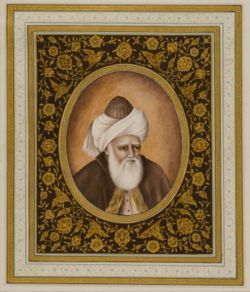Difference between revisions of "The music of Rumi"
| Line 26: | Line 26: | ||
''PART I'' | ''PART I'' | ||
| − | (stage is set | + | (stage is set for Indian ensemble (back a bit) and for small ensemble to accompany Geha (front, stage left). Screen is off to one side, or up high. |
* Blackout.... | * Blackout.... | ||
| Line 40: | Line 40: | ||
* Indian ensemble performance, followed by | * Indian ensemble performance, followed by | ||
| − | * Whirling dervishes projected | + | * Whirling dervishes projected while stage is reset for Kreisha (this should just be a matter of moving some of the equipment already on stage for Indian ensemble) |
* Kreisha's performance | * Kreisha's performance | ||
| Line 53: | Line 53: | ||
''PART II'' | ''PART II'' | ||
| − | (stage | + | (stage is set for MENAME, Mehdi, and Persian group) |
* Blackout...enter Geha's dance-recitations, part II (with violin and tabla) opens second half, followed by | * Blackout...enter Geha's dance-recitations, part II (with violin and tabla) opens second half, followed by | ||
Revision as of 11:21, 15 November 2007
(aka World Music Sampler 2007)

Rumi by Haydar Hatemi
Listen to the reed and the tale it tells,
How it sings of separation...
The music of Rumi is...
- music of his poetry (the sound of language itself, in the original Persian)
- music as metaphor in his poetry (music, instruments, musicians...)
- music of the performed Rumi text
- music as a metaphor for the performance of all mystical love texts
- music as metaphor for the ritual experience of Rumi's poetry, for Rumi as Mevlana, as saint
- music as metaphor for mystical experience and spirituality generally
- music as metaphor for the harmonious machinery of the cosmos, the synchrony of micro/macrocosm, the mutual whirling of human and universe...
Concert sketch:
NB: There should not be an MC or any formal didactic voice; let the program flow present itself, with any needed explications relegated to the printed program
PART I
(stage is set for Indian ensemble (back a bit) and for small ensemble to accompany Geha (front, stage left). Screen is off to one side, or up high.
- Blackout....
- Geha's dance-recitations: poetry of Rumi, with nay and tar (poems: "Out beyond ideas of right and wrong...", "I was buried and rotting...", "Lightning!...", "Tonight there are no limits...")
- Saleem's recitation of Rumi in Farsi, with accompaniment from Regula and Michael, perhaps with some tar
- Geha's dance-recitations: various poems, with violin, nay, tar, accompaniments.
- Whirling dervishes projected onto screen (run throughout, but sound down) while Indian group settles in, transition to
- Indian ensemble performance, followed by
- Whirling dervishes projected while stage is reset for Kreisha (this should just be a matter of moving some of the equipment already on stage for Indian ensemble)
- Kreisha's performance
---start intermission---
(video of whirling dervishes runs with sound up)
---end intermission---
PART II
(stage is set for MENAME, Mehdi, and Persian group)
- Blackout...enter Geha's dance-recitations, part II (with violin and tabla) opens second half, followed by
- Middle Eastern and North African ensemble (MENAME)
- Mehdi Samadi (solo) (poetry of Rumi; recites poetry then sings it)
- Persian group (including poetry of Rumi; recited first)
- Geha: very short Rumi recitation with nay and tar, themes of ecstasy of the dance
- Video of whirling dervishes, while stage is set up for WAME...
- African ensemble (WAME)
- Blackout
- Geha: final Rumi recitations (very short) involving at least one musician from WAME along with her other musicians --- to conclude the program.